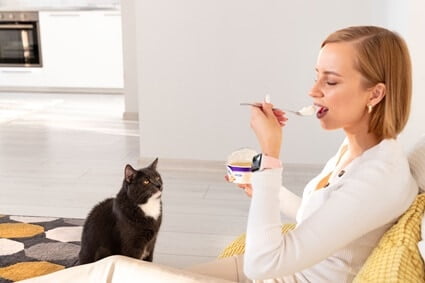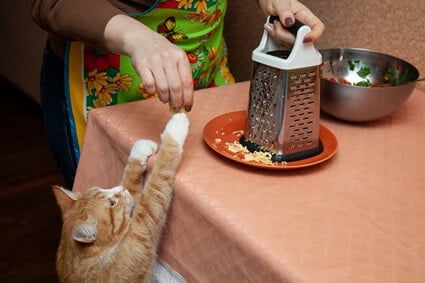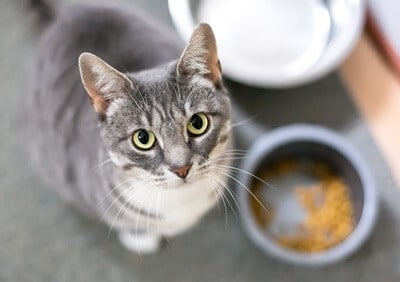Most people adopt cats expecting them to be low maintenance pets. While cats love their mealtimes, they are usually less prone to begging for food than other domesticated animals. There are exceptions to every rule, and some cats take their passion too far and plead for food constantly.
If your cat is gluttonous, you need to show your cat that pleasure can be derived from things other than food. Get the cat into a strict routine of eating alone at set times. Fill the rest of its day with play and petting.
You must train your cat out of begging. You may enjoy short-term peace if you give in, but things will eventually worsen. You cat will gain weight, potentially growing unwell. You are setting a dangerous precedent.
My Cat Begs for Food Like a Dog
Begging is not a cute habit in cats. In fact, it can put real strain on your bond. Many people bring cats into their home as this animal has a reputation for independence. What’s more, cats ordinarily live for routine. Cats should only want to eat at scheduled mealtimes.
A cat that begs for food can be difficult to live with. Nobody wants their cat to be hungry or unhappy. At the same time, acquiescing to every demand for food is dangerous. Not only will your cat gain weight, but you’ll set a precedent that begging gets results.
Most cats will attempt another way to get what it wants. This could include enhanced affection. Cats will do whatever they need to do to get results. Alternatively, some cats will grow aggressive with their demands.
Another outcome could be that your cat grows crafty and steals human food. This could be from your plate or by raiding cupboards. This may be amusing once, but it’s dangerous. Many human foods are toxic to cats.
If your cat has taken to pleading for food, you need to train it out of the habit. The first step to this is learning why the cat wants food all the time. You can then tailor your training accordingly.

My Cat Wants More Food Than Usual
If your cat is asking for food more than it ordinarily does, there will typically be a reason. It’s always possible that your cat is just hungry. This is especially likely if your cat is on a diet. You’ll need to tough out the begging phase in this instance.
Before embarking on training, ensure your cat’s pleading does not have a reasonable explanation. A cat not prone to begging may have a reason for this change in behavior. Not all begging cats are being greedy.
Cold Temperatures
If the ambient temperature of your home is cold, your cat will be hungrier. Most cats eat an average of 15% more food during the winter months. This is because cats burn more calories simply maintaining a comfortable body temperature.
This means that it is OK to offer your cat a little more food in winter. You do not want your cat’s temperature to drop below 100 degrees Fahrenheit. This creates a risk of hypothermia. Adjust portion sizes again in spring.
If you’re reluctant to feed your cat more, provide warmth from other sources. Well-placed blankets and hot water bottles may reduce winter begging for food. Just make sure your cat does not burn its delicate skin on a heat source, such as a radiator.
Pregnancy
Is your cat an unspayed female? If so, she may be pregnant. Pregnant cats are always hungrier. This is not surprising, as she is nourishing a litter of kittens growing inside her. A standard meal will no longer be adequate for a pregnant feline. Other signs that a cat is pregnant include:
- Swollen, bright-colored nipples (aka, “pinking up”)
- Excessive affection
- Weight gain beyond that explainable by additional food intake
- Nesting
Cats in heat can be determined and crafty. Even if you take every precaution, your cat may still escape and mate. The only way to be certain of avoiding unplanned feline pregnancy is spaying.
Intestinal Parasites
Ensure your cat is regularly treated with parasite prevention medication. You’ll find this in any pet store. If your cat is not treated, it may suffer a tapeworm infestation. Tapeworms are often linked to flea infestations, so keep on top of these treatments at same time.
Tapeworms are long, flat parasites that live in your cat’s intestine. They usually peak in size at around eight inches. Tapeworms sustain themselves on the food your cat eats. This means that a cat will appear constantly hungry if it has an infestation. Other symptoms of tapeworms are:
- Dragging the bottom across the floor to relieve itching (aka scooting)
- Tiny, rice-like flecks in the cat’s feces
- Vomiting
You may also see a tapeworm hanging from your cat’s rectum. Never tug on the worm in this instance. It may be wrapped around your cat’s intestine. Sudden movements can cause serious internal damage.
Tapeworms are considered a minor nuisance, but they will make your cat uncomfortable. In addition, they can multiply. This can cause a cat to lose weight at an advanced pace. Thankfully, treatment is cheap, commonplace and quickly effective.
Food was Stolen
Ensure that your cat got to eat. If you have a multi-cat household, a dominant pet may eat all the food. Equally, cats sometimes visit other homes. A neighborhood feline may have entered and eaten your cat’s meal.
Place your cat’s food somewhere secure and attract its attention. Tap the bowl and add an appealing scent to draw the cat in. Don’t stand and watch it eat; that will put the cat off. Once it starts to eat, you can rest assured that it managed to finish its meal.
My Cat Begs for Food When the Bowl is Full
Few things are more frustrating than a cat begging for food when it has been provided. There are three possible explanations.
Inappropriate Food
Cats can be fussy about what they eat. This is why it is important to find food your cat enjoys and stick with it. Cats love routine. They can rarely have too much of a good thing when it comes to food.
All the same, it’s possible you have chosen a flavor not to your cat’s liking. Your cat may be adamant that it wants fish, not chicken, tonight. It is at your discretion how your respond to this. It’s important that cats eat, but equally, be mindful of setting a precedent of fussiness.
A compromise may be to adjust the flavor of an existing food slightly. Add some tuna juice or meat gravy. These scents will convince most cats to eat what is in front of them.
Wrong Temperature
If your cat eats wet food, but the meal may be fine but the temperature inappropriate. Cats like to eat food at room temperature. If the food is straight from the fridge, a cat is likely to reject it.
This is mainly because cats cannot smell chilled food. Cats decide what is potentially tasty through their nose. Once the aroma of food entices a cat, it starts to eat. If the cat is unable to clear this first step of the process, it will beg for more appealing food.
You could try heating the food in a microwave for a few seconds. Most cats will then eat. Just don’t go too far in the opposite direction. Ensure the food is no hotter than room temperature, or the cat risks burning its mouth.
Dental Pain
Consider whether your cat is experiencing dental pain. Cats can develop toothache too, usually as a result of gum disease. This will make it too sore for a cat to chew. Food will be rejected as a source of pain, but the cat will remain hungry. Warning signs of dental pain in cats include:
- Pawing at the face
- Picking up then dropping food
- Discolored gums
- Bad breath
- Excessive drooling, typically from one side of the face
Cats are skilled as masking pain, and many wet cat foods can be swallowed without chewing. You may not realize your cat has dental problems until it’s too late. If this is the case, your cat needs urgent treatment from a vet.
Cats with dental issues will refuse food and water until the pain is resolved. As per the Journal of Small Animal Practice, untreated gum disease can also lead to respiratory infection. Minimize this risk by brushing your cat’s teeth regularly.
How to Stop a Cat from Meowing for Food
Training a cat not to beg for food is challenging. You’ll need an iron will to ignore the meowing. Your cat may even grow aggressive or destructive.
Another challenge in training a cat not to beg for food is that you cannot use treats. As felines are so food-focused, treats are usually the key to gaining attention and engagement. You cannot do this when food is the problem.
Instead, training a cat not to beg for food is based around attention and interaction. In short, you must teach your cat that food is not life’s only pleasure. This is a three-step process.
Routine
You need to gain your cat’s trust. That cat is likely begging because it feels insecure about its food. Provide food at the same time each day. If you cannot meet this expectation, ask a friend or neighbor to help.
Make sure your cat understands when dinner time is. Cats do not tell time in the conventional sense. You could use a command word. Alternatively, teach your cat that food always follows play and petting.
It may take time for your cat to adjust to this routine. You’ll need to remain firm in between. If you choose to offer treats, do this within the same structure. Have an allocated ‘treat window’ where you cat is allowed to snack.
Eventually, your cat will learn to expect food at set times. It will be prepared to wait if it knows that food is coming. Make this waiting worth your cat’s while. Stock up on its favorite foods and praise lavishly when it displays patience.
Distractions
During these in-between times, spend more time with your cat. Show you cat that not everything revolves around food. By offering more play, petting and grooming, your cat will experience more of life’s pleasures.
As with eating, establish a routine for these activities. This gives the cat something to look forward to. If a cat feels secure that its needs will be met, it will relax. It’s likely that a contented cat will doze and nap between human interactions.
Also use these techniques to praise a cat, instead of offering treats. If your cat does something you approve of, shower it with affection. If your cat is more standoffish, consider an alternative reward such as catnip or a toy. Just break the cycle of reliance upon food.
Make the Cat Earn Food
Another technique could be to make your cat earn its food. This could mean it needs to complete a puzzle or perform a trick. The purpose of this is twofold.
It teaches cats that food does not come from begging, but from action. In addition, it will deter lazy cats from eating to excess. Some cats would rather give up their quest for food than work for it.
My Cat is Obsessed with Human Food
Cats growing fascinated by human food can be a real problem. This is especially concerning if it results in a cat stealing food from a plate. This is unhygienic, bad manners, and potentially harmful. Many human foods are dangerous for cats, including:
- Garlic, spices, and onions
- Chocolate
- Grapes and raisins
- Oranges and other citrus fruits
- Alcohol
- Caffeine
- Dairy (rarely toxic, but a common source of stomach upsets)
Time your cat’s meals to not coincide with your own. If your cat is hungry, and its nourishment is appropriate, it will happily eat when fed. If this coincides with human food, though, the cat will prefer your meal to its own.
Part of this is down to the natural feline inclination to imitate humans. The cat will see you eating and assume that it should be devouring the same thing. This is especially likely if you are enjoying some protein-rich meat with a distinct scent.
In addition, this smell may simply captivate the cat. The aroma of cooked chicken or beef is more enticing than a bowl of cat food. This means the cat will ignore what you have provided and ask for your meal instead.
If you feed your cat around an hour before you eat, this becomes less likely. After eating, cats like to groom and doze. If you time things right, your cat will sleep through your dinnertime. Make this routine and the cat will eventually lose interest in human food.
In addition, consider the location of your cat’s dinner. Cats should not eat in the same room as you. Place your cat’s food elsewhere in the home, ideally behind closed doors. This creates a distinction in the cat’s mind. Cat food is to be eaten in assigned territory.
My Cat Wants Treats but Not Food
It’s tempting to treat a cat constantly to show our affection. The cat will go off its food in this instance, though. A traditional meal is boring in comparison. You’ll need to grow more sparing with treats.
This behavior is most common in young cats that have been in training. Teaching your cat to use the litter tray, for example, often results in treats. This gives the cat a taste for delicious snacks. In addition to tasting great, treats are associated with praise and affection.
An older cat that wants treats over food may lack the appetite for a full meal. As cats age, they often seek to eat less. This is because they are burning fewer calories due to an inactive lifestyle. Just double-check that your outdoor cat is not eating elsewhere.

How Do I Know if My Cat is Overeating?
Cat food allowances should be tailored to the feline’s size, lifestyle and breed. A large cat like a Maine Coon will obviously need to eat more than a Munchkin. Cats should eat around 30 calories each day per 10 lbs of optimum body weight.
This is where the caveats start to come in. Note that we refer to optimum body weight. The Journal of the International Association for the Study of Obesity claims that 29% of cats are overweight.
If this is the case, your cat should lose weight, not maintain these extra pounds. That means putting your cat on a diet, which will result in begging. In this instance, you’ll need to be strong. Your cat is used to eating more and will assume you are holding out on them.
You must also consider your cat’s lifestyle. Active cats burn more calories as a matter of course. This will make them hungrier and entitle them to more food. A cat that spends all day dozing will burn virtually no calories. This must be factored into food allowance.
Remember that the calories that your cat consumes is not just limited to canned food, either. Treats between meals must be considered, as must hunting if you cat stalks and eats mice. The average mouse contains around 30 calories.
You’ll know if your cat is overeating by weighing regularly and conducting a basic eye test. If your cat is looking overweight, it probably is. Touch your cat’s belly too, if it allows this. You should be able to feel your cat’s ribs without too much obstruction from body fat.
Ensure your cat is not regularly vomiting or regurgitating food. If this is the case, the cat is likely eating too much. A cat’s small stomach can only hold so much food and excess will be expelled. If this is a regular occurrence, reduce your cat’s portion sizes.
Does it Matter if My Cat Eats Too Much?
As explained by the International Journal of Applied Research in Veterinary Medicine, risk factors of excess weight in cats include:
- Diabetes
- Arthritis and lameness (additional weight applies extra pressure to a cat’s joints)
- Greasy, matted fur (the cat cannot contort itself to groom)
- Skin disease (as the cat cannot groom, oils in the skin are not evenly distributed)
- Urinary tract infections
- Hypertension
This is just one of the reasons why you cannot cave into a cat’s begging for food. Get your cat into a strict routine so it understands that is enough. Sometimes, as a cat owner, you have to be cruel to be kind.
Cats need to quickly learn that begging for food will not yield results. Unless there is a medical explanation for the demands, this requires training.

